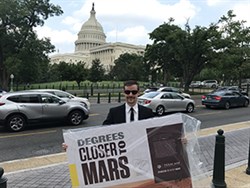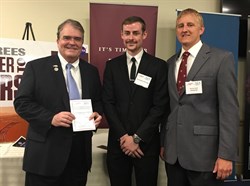 Dr. Darren Hartl, assistant professor in the Department of Aerospace Engineering at Texas A&M University, and former student Christopher Bertagne, traveled to Washington, D.C. to present to three congressmen and their staff members their research performed in collaboration with NASA’s Johnson Space Center and Glenn Research Center on shape memory alloy (SMA)-based morphing radiators.
Dr. Darren Hartl, assistant professor in the Department of Aerospace Engineering at Texas A&M University, and former student Christopher Bertagne, traveled to Washington, D.C. to present to three congressmen and their staff members their research performed in collaboration with NASA’s Johnson Space Center and Glenn Research Center on shape memory alloy (SMA)-based morphing radiators.
The visit to Capitol Hill was in support of an award ceremony sponsored by the Coalition for Aerospace and Science and the Aerospace Industries Association to honor Rep. John Culberson (TX-7), chair of the appropriations subcommittee on commerce, justice and science, for his demonstrated support of NASA throughout the years. In addition to the Texas A&M cohort, researchers from the University of Michigan, University of Colorado, Northrup Grumman and other entities were also on hand to discuss their NASA-funded efforts in various areas.
 Hartl and Bertagne had the chance to brief Culberson about the theory of operation of the proposed morphing radiator concept and presented him with a custom shape memory alloy wire ring that forms the shape of the state of Texas when heated.
Hartl and Bertagne had the chance to brief Culberson about the theory of operation of the proposed morphing radiator concept and presented him with a custom shape memory alloy wire ring that forms the shape of the state of Texas when heated.
 The radiator project is directed by Hartl with co-principal investigator Dr. John Whitcomb, professor in aerospace engineering. The meeting was a special treat for Bertagne, who grew up in Culberson’s district, and was eventually able to realize his life goal of being employed at NASA’s Jet Propulsion Laboratory (JPL) after completing his NASA-funded master’s degree, which focused on the morphing radiator research. Bertagne was able to give widely attended internal NASA seminars on the technology to JPL thermal engineers while still a student.
The radiator project is directed by Hartl with co-principal investigator Dr. John Whitcomb, professor in aerospace engineering. The meeting was a special treat for Bertagne, who grew up in Culberson’s district, and was eventually able to realize his life goal of being employed at NASA’s Jet Propulsion Laboratory (JPL) after completing his NASA-funded master’s degree, which focused on the morphing radiator research. Bertagne was able to give widely attended internal NASA seminars on the technology to JPL thermal engineers while still a student.
Other members of Congress also made the rounds and discussed research interests with Hartl and Bertagne. These included Rep. Bill Flores (TX-17), who represents the district which extends from Texas A&M to Waco and includes parts of north Austin, and Rep. Steve Knight (CA-25), who is a champion for aeronautics research. With Knight in particular, Hartl had a chance to discuss his research on shape-adaptive low-boom supersonic aircraft.